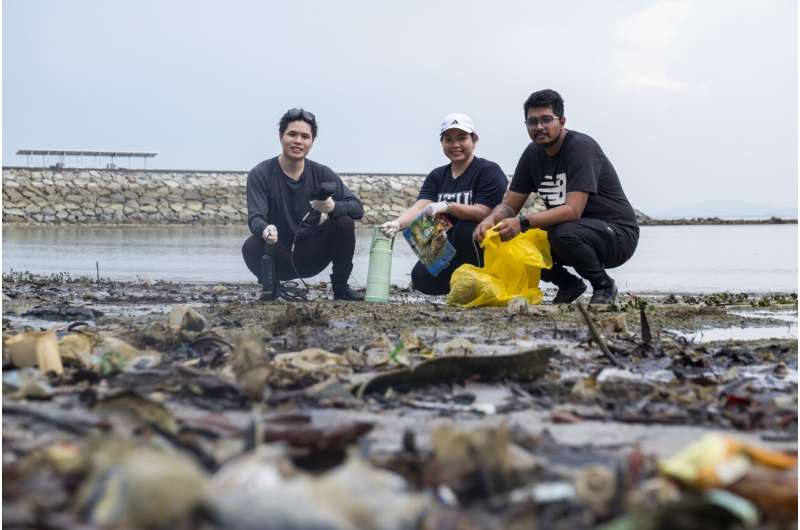This article has been reviewed according to Science X's editorial process and policies. Editors have highlighted the following attributes while ensuring the content's credibility:
fact-checked
peer-reviewed publication
trusted source
proofread
Potential threats, promising resources in thriving colonies of bacteria and fungi on ocean plastic trash

A team of scientists from the Nanyang Technological University, Singapore (NTU Singapore) has found both potential threats and promising resources in the thriving colonies of bacteria and fungi on plastic trash washed up on Singapore shores.
When plastics enter the ocean, microorganisms attach to and colonize them, forming an ecological community known as the plastisphere. Despite the millions of tons of plastic trash in the world's oceans, little is known about how the plastisphere assembles and interacts with its plastic hosts in tropical marine environments.
To understand the plastic-microbes interaction, NTU researchers extracted DNA information of plastispheres gathered from 14 coastal locations in Singapore. They found potential plastic-eating bacteria and harmful microbes thriving on the samples.
The study, published in Environment International in September, is among the few plastisphere studies in the Southeast Asian tropical marine and coastal environment, including coral reefs, mangrove forests, seagrass beds, beaches, and open waters.
Lead author of the study, NTU doctoral student Jonas Koh, at the Singapore Center for Environmental Life Sciences Engineering (SCELSE), said, "The plastisphere can influence the fate of plastic debris, breaking it down into microplastics, causing them to sink or float, for example. Yet very little is known about what kinds of microbes are in the plastisphere in tropical coastal marine environments.
"How do they interact with each other? How does the plastic debris influence their development? We want to know the answers to these questions, which can help policymakers make informed decisions to reduce potential threats to our Southeast Asia ocean ecosystem."
Plastisphere impacts the health of coastal ecosystems
The NTU research team used advanced DNA sequencing techniques to find at least 1,000 microorganisms (i.e., bacteria and algae) thriving on the plastic samples. Of these, several are potentially harmful to the tropical marine and coastal environment.
Labyrinthulaceae, a harmful microorganism, was found on plastics gathered from all sampled habitats with varying degrees of abundance. In North America, this type of microorganism causes seagrass wasting disease, which affects seagrass health and leads to mass die-offs.
The cyanobacteria Lyngbya, a type of bacteria that obtains energy through sunlight (photosynthesis), was also abundant on plastics collected from the coastal habitats. Lyngbya has been known to poison marine life, such as shellfish. Acinetobacter and Parvularculaceae—bacteria associated with coral diseases like Dark Spot Syndrome, where corals become discolored—were also abundant on plastics.
Co-author, Zin Thida Cho, NTU Research Associate, at the School of Civil and Environmental Engineering (CEE) and SCELSE, said, "The fact that potentially harmful microorganisms have been discovered on the plastic debris is worrying, as this suggests that marine plastics create a pathway for them to move between habitats, potentially infecting ocean life across Southeast Asia."
Potential microbial resource for use in plastic management
Alongside the discovery of potentially harmful microorganisms, the NTU team also found potential plastic-eating bacteria, such as Muricauda, Halomonas, and Brevundimonas, bringing hope that the bacterial strains might be exploited to speed up plastic degradation.
Co-author, Dr. Sakcham Bairoliya, NTU research fellow at the School of CEE, and SCELSE, said, "The presence of potential plastic-eating bacteria in the coastal plastispheres presents an opportunity to use these microorganisms in the plastics degradation process. Our lab plans to explore this area in future studies to contribute to developing environmentally friendly plastics and novel plastic waste management processes."
Sediments influence plastisphere
The scientists also compared the microorganisms found on the plastic debris, nearby sediments (where plastic samples were collected from), and the surrounding seawater to understand what enables them to thrive.
The results showed that sediments predominantly influenced the composition of plastisphere communities in the coastal locations. While more research is needed to uncover why sediments affect the plastisphere disproportionately, the NTU team said the discovery highlights the far-ranging impacts of ocean plastic pollution.
NTU Associate Professor Cao Bin, at the School of CEE, and principal investigator at SCELSE, said, "We have now found evidence that plastic debris washed up on our coastal environments harbor very diverse microorganisms, and that such microorganisms are influenced by the environment in which the plastics interact with. Environmental policies should, therefore, consider the impact of both plastics and microbial communities that colonize the plastics. Plastic pollution not only threatens marine creatures, but also causes stress on habitats like mangrove trees, seagrasses, and corals."
In future studies, the NTU team is also looking to investigate how the microbial communities in the plastisphere adhere to different types of plastics and how they evolve in different environments.
More information: Jonas Koh et al, Sediment-driven plastisphere community assembly on plastic debris in tropical coastal and marine environments, Environment International (2023). DOI: 10.1016/j.envint.2023.108153
Journal information: Environment International
Provided by Nanyang Technological University




















